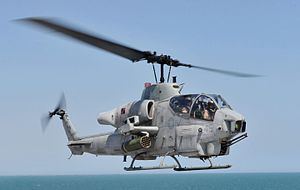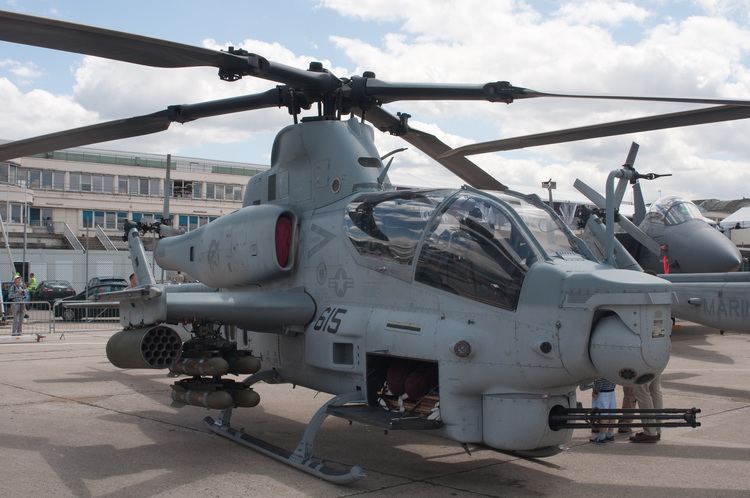Top speed 282 km/h Wingspan 15 m First flight 1969 | Length 18 m Engine type Turboshaft Manufacturer Bell Helicopter | |
 | ||
The Bell AH-1 SuperCobra is a twin-engine attack helicopter based on the United States Army's single-engine AH-1 Cobra. The twin Cobra family, itself part of the larger Huey family, includes the AH-1J SeaCobra, the AH-1T Improved SeaCobra, and the AH-1W SuperCobra. The AH-1W has been the backbone of the United States Marine Corps's attack helicopter fleet, but is being replaced by the Bell AH-1Z Viper.
Contents
- Design and development
- United States
- Iran
- Taiwan
- Turkey
- Single engine
- Twin engine
- Operators
- Aircraft on display
- AH 1J SeaCobra
- AH 1W SuperCobra
- References

Design and development
The AH-1 Cobra was developed in the mid-1960s as an interim gunship for the U.S. Army for use during the Vietnam War. The Cobra shared the proven transmission, rotor system, and the T53 turboshaft engine of the UH-1 "Huey". By June 1967, the first AH-1G HueyCobras had been delivered. Bell built 1,116 AH-1Gs for the U.S. Army between 1967 and 1973, and the Cobras chalked up over a million operational hours in Vietnam.
The U.S. Marine Corps was very interested in the AH-1G Cobra, but it preferred a twin-engine version for improved safety in over-water operations, and also wanted a more potent turret-mounted weapon. At first, the Department of Defense had balked at providing the Marines with a twin-engine version of the Cobra, in the belief that commonality with Army AH-1Gs outweighed the advantages of a different engine fit. However, the Marines won out and awarded Bell a contract for 49 twin-engine AH-1J SeaCobras in May 1968. As an interim measure, the U.S. Army passed on 38 AH-1Gs to the Marines in 1969. The AH-1J also received a more powerful gun turret. It featured a three barrel 20 mm XM197 cannon that was based on the six barrel M61 Vulcan cannon.

The Marine Corps requested greater load carrying capability in high temperatures for the Cobra in the 1970s. Bell used systems from its Model 309 to develop the AH-1T. This version had a lengthened tailboom and fuselage with an upgraded transmission and engines from the 309. Bell designed the AH-1T to be more reliable and easier to maintain in the field. The version was given full TOW missile capability with targeting system and other sensors. An advanced version, known as the AH-1T+ with more powerful T700-GE-700 engines and advanced avionics was proposed to Iran in the late 1970s, but the overthrow of the Shah of Iran resulted in the sale being canceled.

In the early 1980s, the U.S. Marine Corps sought a new navalized helicopter, but it was denied funding to buy the AH-64 Apache by Congress in 1981. The Marines in turn pursued a more powerful version of the AH-1T. Other changes included modified fire control systems to carry and fire AIM-9 Sidewinder and AGM-114 Hellfire missiles. The new version was funded by Congress and received the AH-1W designation. Deliveries of AH-1W SuperCobras totaled 179 new-built helicopters plus 43 upgrades of AH-1Ts.

The AH-1T+ demonstrator and AH-1W prototype were later tested with a new experimental composite four-blade main rotor system. The new system offered better performance, reduced noise and improved battle damage tolerance. Lacking a USMC contract, Bell developed this new design into the AH-1Z with its own funds. By 1996, the Marines were again not allowed to order the AH-64. Developing a marine version of the Apache would have been expensive and it was likely that the Marine Corps would be its only customer. They instead signed a contract for upgrading AH-1Ws into AH-1Zs.
The Bell AH-1Z Viper features several design changes. The AH-1Z's two redesigned wing stubs are longer with each adding a wingtip station for a missile such as the AIM-9 Sidewinder. Each wing has two other stations for 70 mm (2.75 in) Hydra rocket pods, or AGM-114 Hellfire quad missile launcher. The Longbow radar can be mounted on a wingtip station. The AH-1W version will be phased out of the Marine Corps by 2020.
United States
During the closing months of the United States' involvement in the Vietnam War, the Marine Corps embarked the AH-1J SeaCobra assigned to HMA-369 (now HMLA-369) aboard Denver, Cleveland, and later Dubuque, for sea-based interdiction of the Ho Chi Minh Trail in North Vietnam in the vicinity of Hon La (Tiger) Island. These were termed Marine Hunter-Killer (MARHUK) Operations and lasted from June to December 1972.
Marine Cobras took part in the invasion of Grenada, during Operation Urgent Fury in 1983, flying close-support and helicopter escort missions. Two Marine AH-1Ts were shot down and three crew members killed. The Marines also deployed the AH-1 off the coast of Beirut, Lebanon in 1983, during that nation's civil war. The AH-1s were armed with Sidewinder missiles and guns as an emergency air defense measure against the threat of light civil aircraft employed by suicide bombers.
USMC Cobras provided escort in the Persian Gulf in the late 1980s while the Iran–Iraq War was ongoing. The Cobras sank three Iranian patrol boats while losing one AH-1T to Iranian anti-aircraft fire. USMC Cobras from Saipan flew "top cover" during an evacuation of American and other foreign nationals from Liberia in 1990.
During the Gulf War, 78 Marine SuperCobras deployed, and flew a total of 1,273 sorties in Iraq with no combat losses. However, three AH-1s were lost to accidents during and after the combat operations. The AH-1W units were credited with destroying 97 tanks, 104 armored personnel carriers and vehicles, and two anti-aircraft artillery sites during the 100-hour ground campaign.
Marine Cobras provided support for the US humanitarian intervention in Somalia, during Operation Restore Hope in 1992-93. They were also employed during the U.S. invasion of Haiti in 1994. USMC Cobras were used in U.S. military interventions in the former Yugoslavia in the 1990s, and two AH-1Ws assisted in the rescue of USAF Captain Scott O'Grady, after his F-16 was shot down by a SAM in June 1995.
AH-1 Cobras continue to operate with the U.S. Marine Corps. USMC Cobras were also used in operations throughout the 1990s. USMC Cobras have also served in Operation Enduring Freedom in Afghanistan and in Operation Iraqi Freedom in the conflict in Iraq. While new replacement aircraft were considered as an alternative to major upgrades of the AH-1 fleet, Marine Corps studies showed that an upgrade was the most affordable, most supportable and most effective solution for the Marine Corps light attack helicopter mission.
During the March 2003 Iraq campaign, 46 of 58 USMC Cobras took battle damage, mostly from infantry-type weapons.
On 19 September 2011, an AH-1W crashed during training exercises at Camp Pendleton, California, killing the two Marine crewmembers on board. An investigation into the crash determined that it was caused by bird strike. The aircraft collided with a Red-tailed Hawk, the impact damaging the pitch change link which in turn produced vibrations to the rotors so fierce that they caused the transmission and rotors to break off from the helicopter body.
In late August 2016, Marine AH-1W Cobras flying from the USS Wasp started flying combat missions over Sirte, Libya against the Islamic State of Iraq and the Levant in Libya, providing close air support for friendly militias on the ground.
Iran
In 1971, Iran purchased 202 of an improved AH-1J, named "AH-1J International", from the United States. This improved Cobra featured an uprated P&WC T400-WV-402 engine and stronger drivetrain. Recoil damping gear was fitted to the 20 mm M-197 gun turret, and the gunner was given a stabilized sight and even a stabilized chair. Of the AH-1Js delivered to the Shah's Imperial Iranian Army Aviation, 62 were TOW-capable.
Iranian AH-1Js participated in the Iran–Iraq War—which saw the most intensive use of helicopters in any conventional war. Iranian AH-1Js (particularly the TOW-capable ones) were "exceptionally effective" in anti-armor warfare, inflicting heavy losses on Iraqi armored and vehicle formations. In operations over the barren terrain in Khuzestan and later in southern Iraq, beside the standard tactics, Iranian pilots developed special, effective tactics, often in the same manner as the Soviets did with their Mi-24s. Due to the post-Revolution weapons sanctions, Iranians had to make do with what was at hand: they equipped the Cobras with AGM-65 Maverick missiles and used them with some success.
Starting from October 1980, the AH-1Js engaged in air-to-air combat with Iraqi Mil Mi-24 helicopters on several, separate occasions during the Iran–Iraq War. The results of these engagements are disputed. One document cited that Iranian AH-1Js took on Iraqi Mi-8 and Mi-24 helicopters. Sources report that the Iranian AH-1 pilots achieved a 10:1 kill ratio over the Iraqi helicopter pilots during these engagements (1:5). Additionally, one source states that ten Iranian AH-1Js were lost in the war, compared to six Iraqi Mi-24s lost. The skirmishes are described as fairly evenly matched in another source. The Mi-24 was faster and more powerful, but the AH-1J was more agile. There were even engagements between Iranian AH-1Js and Iraqi fixed-wing aircraft. The AH-1Js scored three confirmed kills against MiG-21s, claimed a Su-20, and shared in the destruction of a MiG-23—all using their 20 mm M197 cannon. About half of the AH-1Js were lost during the conflict to combat, accidents, and simple wear and tear. Ali Akbar Shiroodi and Ahmad Keshvari were two distinguished Iranian Cobra pilots during Iran-Iraq War and are considered wartime heroes in Iran.
In 1988, two Soviet MiG-23s shot down a pair of Iranian AH-1Js that had strayed into western Afghan airspace.
Iranian AH-1Js are in service with the Islamic Republic of Iran Army Aviation and have undergone indigenous upgrade programs.
Taiwan
In 1984, the Republic of China (Taiwan) announced a requirement for attack helicopters and evaluated the MBB Bo 105 and MD 500 helicopters. The requirement formed into an order for 42 AH-1W SuperCobras by 1992. Deliveries of these went from 1993-1997. Another 21 AH-1Ws was ordered in 1997. The Ministry of National Defense assigned the helicopters to the ROC Army Aviation Training Centre and two Army Aviation attack helicopter brigades.
Turkey
Turkey bought ten AH-1W SuperCobras in the early 1990s, and supplemented with 32 ex-US Army AH-1 Cobras. The AH-1s have been used against the Kurdistan Workers' Party (PKK) rebels. In late 2011, Turkey requested the purchase of three AH-1Ws from the USMC inventory.
On May 13, 2016, PKK militants shot down a Turkish Army AH-1W SuperCobra using a 9K38 Igla (SA-18 Grouse) MANPADS. In the published video, the missile severed the tail section from the rest of the helicopter, causing it to spin, fragment in midair and crash, killing the two pilots on board. The Turkish government first claimed that it fell due to technical failure, then it became obvious that it had been shot down'.
Single-engine
For AH-1G, AH-1Q through AH-1S/P/E/F and other single-engine variants, see Bell AH-1 Cobra.Twin-engine
Operators
Aircraft on display
AH-1J SeaCobra
Data from Verier, Modern Fighting Aircraft,
General characteristics
Performance
Armament
AH-1W SuperCobra
Data from Verier, Modern Fighting Aircraft, International Directory of Military Aircraft
General characteristics
Performance
Armament
